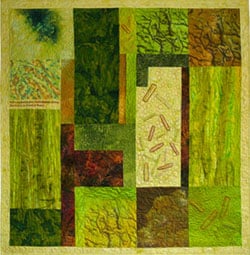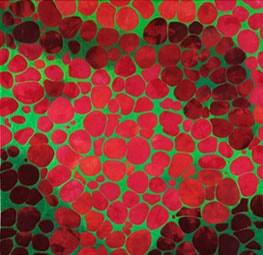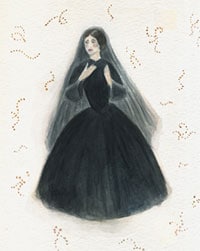Art Meets Science
Studio Art Quilt Associates, Inc.
June 11 – September 5, 2012
Art Meets Science, organized by the Studio Art Quilt Association, features thirty-five textiles by international artists—all masters in transforming quilt making into art making. Collectively, the textiles draw upon scientific theories or phenomena in new and unexpected ways. They illustrate, with strikingly visual impact, a gamut of scientific ideas, from the harmonies of randomness to the dynamics produced by scientific imagery. Many of the quilts are inspired by the “world unseen”—microscopic reflections of viruses, bacteria, and other cellular forms. David W. Fraser, M.D., the exhibition juror and a textile expert, is also an epidemiologist who was one of the leaders of CDC’s Legionnaires’ disease investigation in 1976-77.


Left: Anita Welty, Virus H5N1, 2009. Right: Virginia Abrams, Lipid Cells, 2009.

Costume design for one of The Twelve Mourning Mothers on a ground of Streptococcus Pyogenes, the bacteria responsible for most cases of Childbed Fever.
Savior of Mothers: The Forgotten Ballet of Dr. Ignaz Semmelweis
Joanna Ebenstein – Morbid Anatomy Blog and Library
June 11 – September 5, 2012
Savior of Mothers: The Forgotten Ballet of Dr. Ignaz Semmelweis is an installation of artifacts and ephemera related to an imaginary 19th century ballet created by artist Joanna Ebenstein. The ballet is based on the true story of the brilliant, yet reviled Hungarian doctor Ignaz Semmelweis (1818-1865). Scenes range from his earliest attempts to curb the “childbed fever” epidemic in his Viennese obstetrical clinic to his premature death of the very disease he had spent his life trying to defeat. Ebenstein was drawn to Semmelweis’ distinctive story not only for its topical and scientific theme—albeit tinged by melodrama and mythic elements—but also for its mixture of beauty and the grotesque. His tale, best suited to the form of a popular tragedy, makes ballet the ideal medium for Semmelweis’ tale. Ebenstein’s installation includes costume designs for the “Plague Demons of Cadaverous Particles”—expressionistic representations of the virulent bacteria Streptococcus pyogenes itself—and the “12 mourning mothers from beyond the grave,” as well as model theaters, posters, programs, and more.
Joanna Ebenstein is a New York-based multi-disciplinary artist and independent scholar with an academic background in intellectual history. She runs the popular Morbid Anatomy blog and the related open-to-the-public Morbid Anatomy Library, and is the founding member of the art/science gallery/lecture space Observatory. Her work centers around the interstices of art and science, death and culture, religion and spectacle, collectors and collecting, and the sublimation of pre-modern ways of thinking into the modern age. Recent exhibitions include Anatomical Theatre, a photo exhibition celebrating medical museums around the world; The Secret Museum, a photo exhibition exploring the poetics of hidden, untouched and curious collections; and her current exhibition The Great Coney Island Spectacularium, which explores turn of the 20th century Coney Island as the pinnacle of pre-cinematic immersive amusement.